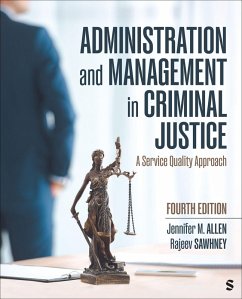Jennifer M. Allen, Rajeev Sawhney
Administration and Management in Criminal Justice
A Service Quality Approach
Jennifer M. Allen, Rajeev Sawhney
Administration and Management in Criminal Justice
A Service Quality Approach
- Broschiertes Buch
Andere Kunden interessierten sich auch für
![How the Obama Administration Has Politicized Justice How the Obama Administration Has Politicized Justice]() Andrew C McCarthyHow the Obama Administration Has Politicized Justice7,49 €
Andrew C McCarthyHow the Obama Administration Has Politicized Justice7,49 €![Homeland Security and Criminal Justice Homeland Security and Criminal Justice]() Homeland Security and Criminal Justice55,99 €
Homeland Security and Criminal Justice55,99 €![Final Report Law Enforcement and Criminal Justice Under Public Law 280 - Scholar's Choice Edition Final Report Law Enforcement and Criminal Justice Under Public Law 280 - Scholar's Choice Edition]() Carole GoldbergFinal Report Law Enforcement and Criminal Justice Under Public Law 280 - Scholar's Choice Edition29,99 €
Carole GoldbergFinal Report Law Enforcement and Criminal Justice Under Public Law 280 - Scholar's Choice Edition29,99 €![Black Lives Don't Matter In America's Criminal Justice System Black Lives Don't Matter In America's Criminal Justice System]() Terry NelsonBlack Lives Don't Matter In America's Criminal Justice System13,99 €
Terry NelsonBlack Lives Don't Matter In America's Criminal Justice System13,99 €![Public Administration & Management in South Africa: An Introduction Public Administration & Management in South Africa: An Introduction]() Christa de WetPublic Administration & Management in South Africa: An Introduction35,99 €
Christa de WetPublic Administration & Management in South Africa: An Introduction35,99 €![The Criminal The Criminal]() Havelock EllisThe Criminal24,99 €
Havelock EllisThe Criminal24,99 €![Evidence-Based Practice Skills Assessment for Criminal Justice Organizations, Version 1.0 - Scholar's Choice Edition Evidence-Based Practice Skills Assessment for Criminal Justice Organizations, Version 1.0 - Scholar's Choice Edition]() Christine A AmeenEvidence-Based Practice Skills Assessment for Criminal Justice Organizations, Version 1.0 - Scholar's Choice Edition17,99 €
Christine A AmeenEvidence-Based Practice Skills Assessment for Criminal Justice Organizations, Version 1.0 - Scholar's Choice Edition17,99 €-
-
-
Produktdetails
- Verlag: SAGE Publications
- Erscheinungstermin: 14. November 2025
- Englisch
- Abmessung: 231mm x 187mm
- ISBN-13: 9781071878170
- ISBN-10: 1071878174
- Artikelnr.: 75011817
- Herstellerkennzeichnung
- Libri GmbH
- Europaallee 1
- 36244 Bad Hersfeld
- gpsr@libri.de
Jennifer M. Allen is a professor in the School of Criminal Justice at Nova Southeastern University and former department head of the Department of Criminal Justice at the University of North Georgia. She has worked with juveniles in detention, on probation, and with those victimized by abuse and neglect. Dr. Allen has served on advisory boards for Big Brother/Big Sister mentoring programs, Rainbow Children's Home, domestic violence/sexual assault programs, and teen courts. Dr. Allen has published in the areas of restorative justice, juvenile delinquency and justice, youth programming, police crime, and policing administration and ethics. She is also the coauthor of Criminal Justice Administration: A Service Quality Approach; The SAGE Guide to Writing in Criminal Justice; The SAGE Guide to Writing in Research Methods; The SAGE Guide to Writing in Corrections; and The SAGE Guide to Writing in Policing.
Preface
Acknowledgments
Chapter 1: Defining Management and Organization
Defining Management
Identifying An Organization
Leadership
For-Profit and Nonprofit Organizations
What Are Criminal Justice Organizations?
Chapter Summary
Chapter Review Questions
Case Study
Questions For Discussion
Additional Resources
References And Suggested Readings
Chapter 2: Open Versus Closed Systems
Closed-System Models: The Classical Perspective
Changing Face Of The Criminal Justice System-Need For A Learning
Organization
Chapter Summary
Chapter Review Questions
Case Study
Questions For Discussion
Additional Resources
References And Suggested Readings
Chapter 3: Service Quality Approach
The Role Of Services In An Economy
Definition Of Service
Characteristics Of Services
Customer Involvement In The Criminal Justice System
Defining Service Quality
Measuring Service Quality
Scope Of Service Quality In The Criminal Justice System
Chapter Summary
Chapter Review Questions
Case Study
Questions For Discussion
Additional Resources
Note
References And Suggested Readings
Chapter 4: Environmental Influences
Funding In Criminal Justice
Technology In Criminal Justice
Cultural And Demographic Issues
Legal Pressures
Unions
Politics
Media
Chapter Summary
Chapter Review Questions
Case Study
Questions For Discussion
Additional Resources
References And Suggested Readings
Chapter 5: Conflict, Power, And Ethical Issues
Organizational Conflict
Power
Ethical Decision Making/Institutional Racism
Chapter Summary
Chapter Review Questions
Case Study
Questions For Discussion
Additional Resources
References And Suggested Readings
Chapter 6: Motivation
Content/Needs Theories
Process Theories
Motivation And Performance
Workplace Design To Promote Motivation
Chapter Summary
Chapter Review Questions
Case Study
Questions For Discussion
Additional Resources
References And Suggested Readings
Chapter 7: Leadership
Leadership Versus Management
Contingency Theories Of Leadership (Situational Leadership Models)
Transactional Leadership Theory
New Wave Of Change Leadership Theories
Leadership As A Skill
Leadership And The Criminal Justice System
Chapter Summary
Chapter Review Questions
Case Study
Questions For Discussion
Additional Resources
References And Suggested Readings
Chapter 8: Communication
Definition
Organizational Needs Fulfilled By Communication
Interpersonal Communication
Communication Channels
Organizational Communication
Technology Interface For Better Service Quality
Chapter Summary
Chapter Review Questions
Case Study
Questions For Discussion
Additional Resources
References And Suggested Readings
Note
Chapter 9: Police Administration
Brief History Of Policing
Private Policing
Policing Agencies
Police Functions
Organization And Structure Of Police Departments
Community Policing: The Opportunity To Provide Quality Services
Chapter Summary
Chapter Review Questions
Case Study
Questions For Discussion
Additional Resources
References And Suggested Readings
Chapter 10: Courts
The Court System
Court Personnel
Federal Court Organization
Federal Court Design
Theories Of Judicial Decision Making
State Court Organization
Specialty Courts
Juvenile Courts
Goals Of The Juvenile Court
State Court Management
Chapter Summary
Chapter Review Questions
Case Study
Questions For Discussion
Additional Resources
References And Suggested Readings
Chapter 11: Probation And Parole
Probation
Parole
Probation And Parole Officers
The Structure Of Probation And Parole
Issues Confronting Probation And Parole
Adaptations Made In Probation And Parole To Meet Client And Community Needs
Chapter Summary
Chapter Review Questions
Case Study
Questions For Discussion
Additional Resources
References And Suggested Readings
Chapter 12: Prisons, Jails, And Detention Centers
A Brief History Of Prisons In The United States
Incarceration Rates
Correctional Facilities At The Federal Level
Correctional Facilities At The State Level
Centralization Versus Decentralization In Prisons And Prison Systems
Organizational Structure Of Prisons
Correctional Facilities At The Local Level: Jails
Jail Design
Organizational Structure Of Jails
Issues Confronting Correctional Centers
Chapter Summary
Chapter Review Questions
Case Study
Questions For Discussion
Additional Resources
References And Suggested Readings
Chapter 13: Private Security Management*
Development Of Private Security
Issues And Growth Of Private Security
Crime Trends And Security
The Aftermath Of September 11, 2001
Management Approaches
Contract Versus Proprietary Services
Differences In Private Security And Public Law Enforcement
Chapter Summary
Chapter Review Questions
Case Study
Questions For Discussion
Additional Resources
References And Suggested Readings
Chapter 14: Measuring Organizational Effectiveness And Service Quality
Application Of Customer Orientation Theory To Enhance Service Quality
Understanding The Dual Role Of Criminal Justice Services
Using QFD: Incorporating The Voice Of The Customer In Improving Service
Quality
Designing Customer-Oriented Criminal Justice Services
Tools To Build Quality In The Criminal Justice Service Delivery Process
Chapter Summary
Chapter Review Questions
Case Study
Questions For Discussion
Additional Resources
References And Suggested Readings
Appendix: Constructing QFD for Law Enforcement Services in Happymore
Index
About the Authors
Acknowledgments
Chapter 1: Defining Management and Organization
Defining Management
Identifying An Organization
Leadership
For-Profit and Nonprofit Organizations
What Are Criminal Justice Organizations?
Chapter Summary
Chapter Review Questions
Case Study
Questions For Discussion
Additional Resources
References And Suggested Readings
Chapter 2: Open Versus Closed Systems
Closed-System Models: The Classical Perspective
Changing Face Of The Criminal Justice System-Need For A Learning
Organization
Chapter Summary
Chapter Review Questions
Case Study
Questions For Discussion
Additional Resources
References And Suggested Readings
Chapter 3: Service Quality Approach
The Role Of Services In An Economy
Definition Of Service
Characteristics Of Services
Customer Involvement In The Criminal Justice System
Defining Service Quality
Measuring Service Quality
Scope Of Service Quality In The Criminal Justice System
Chapter Summary
Chapter Review Questions
Case Study
Questions For Discussion
Additional Resources
Note
References And Suggested Readings
Chapter 4: Environmental Influences
Funding In Criminal Justice
Technology In Criminal Justice
Cultural And Demographic Issues
Legal Pressures
Unions
Politics
Media
Chapter Summary
Chapter Review Questions
Case Study
Questions For Discussion
Additional Resources
References And Suggested Readings
Chapter 5: Conflict, Power, And Ethical Issues
Organizational Conflict
Power
Ethical Decision Making/Institutional Racism
Chapter Summary
Chapter Review Questions
Case Study
Questions For Discussion
Additional Resources
References And Suggested Readings
Chapter 6: Motivation
Content/Needs Theories
Process Theories
Motivation And Performance
Workplace Design To Promote Motivation
Chapter Summary
Chapter Review Questions
Case Study
Questions For Discussion
Additional Resources
References And Suggested Readings
Chapter 7: Leadership
Leadership Versus Management
Contingency Theories Of Leadership (Situational Leadership Models)
Transactional Leadership Theory
New Wave Of Change Leadership Theories
Leadership As A Skill
Leadership And The Criminal Justice System
Chapter Summary
Chapter Review Questions
Case Study
Questions For Discussion
Additional Resources
References And Suggested Readings
Chapter 8: Communication
Definition
Organizational Needs Fulfilled By Communication
Interpersonal Communication
Communication Channels
Organizational Communication
Technology Interface For Better Service Quality
Chapter Summary
Chapter Review Questions
Case Study
Questions For Discussion
Additional Resources
References And Suggested Readings
Note
Chapter 9: Police Administration
Brief History Of Policing
Private Policing
Policing Agencies
Police Functions
Organization And Structure Of Police Departments
Community Policing: The Opportunity To Provide Quality Services
Chapter Summary
Chapter Review Questions
Case Study
Questions For Discussion
Additional Resources
References And Suggested Readings
Chapter 10: Courts
The Court System
Court Personnel
Federal Court Organization
Federal Court Design
Theories Of Judicial Decision Making
State Court Organization
Specialty Courts
Juvenile Courts
Goals Of The Juvenile Court
State Court Management
Chapter Summary
Chapter Review Questions
Case Study
Questions For Discussion
Additional Resources
References And Suggested Readings
Chapter 11: Probation And Parole
Probation
Parole
Probation And Parole Officers
The Structure Of Probation And Parole
Issues Confronting Probation And Parole
Adaptations Made In Probation And Parole To Meet Client And Community Needs
Chapter Summary
Chapter Review Questions
Case Study
Questions For Discussion
Additional Resources
References And Suggested Readings
Chapter 12: Prisons, Jails, And Detention Centers
A Brief History Of Prisons In The United States
Incarceration Rates
Correctional Facilities At The Federal Level
Correctional Facilities At The State Level
Centralization Versus Decentralization In Prisons And Prison Systems
Organizational Structure Of Prisons
Correctional Facilities At The Local Level: Jails
Jail Design
Organizational Structure Of Jails
Issues Confronting Correctional Centers
Chapter Summary
Chapter Review Questions
Case Study
Questions For Discussion
Additional Resources
References And Suggested Readings
Chapter 13: Private Security Management*
Development Of Private Security
Issues And Growth Of Private Security
Crime Trends And Security
The Aftermath Of September 11, 2001
Management Approaches
Contract Versus Proprietary Services
Differences In Private Security And Public Law Enforcement
Chapter Summary
Chapter Review Questions
Case Study
Questions For Discussion
Additional Resources
References And Suggested Readings
Chapter 14: Measuring Organizational Effectiveness And Service Quality
Application Of Customer Orientation Theory To Enhance Service Quality
Understanding The Dual Role Of Criminal Justice Services
Using QFD: Incorporating The Voice Of The Customer In Improving Service
Quality
Designing Customer-Oriented Criminal Justice Services
Tools To Build Quality In The Criminal Justice Service Delivery Process
Chapter Summary
Chapter Review Questions
Case Study
Questions For Discussion
Additional Resources
References And Suggested Readings
Appendix: Constructing QFD for Law Enforcement Services in Happymore
Index
About the Authors
Preface
Acknowledgments
Chapter 1: Defining Management and Organization
Defining Management
Identifying An Organization
Leadership
For-Profit and Nonprofit Organizations
What Are Criminal Justice Organizations?
Chapter Summary
Chapter Review Questions
Case Study
Questions For Discussion
Additional Resources
References And Suggested Readings
Chapter 2: Open Versus Closed Systems
Closed-System Models: The Classical Perspective
Changing Face Of The Criminal Justice System-Need For A Learning
Organization
Chapter Summary
Chapter Review Questions
Case Study
Questions For Discussion
Additional Resources
References And Suggested Readings
Chapter 3: Service Quality Approach
The Role Of Services In An Economy
Definition Of Service
Characteristics Of Services
Customer Involvement In The Criminal Justice System
Defining Service Quality
Measuring Service Quality
Scope Of Service Quality In The Criminal Justice System
Chapter Summary
Chapter Review Questions
Case Study
Questions For Discussion
Additional Resources
Note
References And Suggested Readings
Chapter 4: Environmental Influences
Funding In Criminal Justice
Technology In Criminal Justice
Cultural And Demographic Issues
Legal Pressures
Unions
Politics
Media
Chapter Summary
Chapter Review Questions
Case Study
Questions For Discussion
Additional Resources
References And Suggested Readings
Chapter 5: Conflict, Power, And Ethical Issues
Organizational Conflict
Power
Ethical Decision Making/Institutional Racism
Chapter Summary
Chapter Review Questions
Case Study
Questions For Discussion
Additional Resources
References And Suggested Readings
Chapter 6: Motivation
Content/Needs Theories
Process Theories
Motivation And Performance
Workplace Design To Promote Motivation
Chapter Summary
Chapter Review Questions
Case Study
Questions For Discussion
Additional Resources
References And Suggested Readings
Chapter 7: Leadership
Leadership Versus Management
Contingency Theories Of Leadership (Situational Leadership Models)
Transactional Leadership Theory
New Wave Of Change Leadership Theories
Leadership As A Skill
Leadership And The Criminal Justice System
Chapter Summary
Chapter Review Questions
Case Study
Questions For Discussion
Additional Resources
References And Suggested Readings
Chapter 8: Communication
Definition
Organizational Needs Fulfilled By Communication
Interpersonal Communication
Communication Channels
Organizational Communication
Technology Interface For Better Service Quality
Chapter Summary
Chapter Review Questions
Case Study
Questions For Discussion
Additional Resources
References And Suggested Readings
Note
Chapter 9: Police Administration
Brief History Of Policing
Private Policing
Policing Agencies
Police Functions
Organization And Structure Of Police Departments
Community Policing: The Opportunity To Provide Quality Services
Chapter Summary
Chapter Review Questions
Case Study
Questions For Discussion
Additional Resources
References And Suggested Readings
Chapter 10: Courts
The Court System
Court Personnel
Federal Court Organization
Federal Court Design
Theories Of Judicial Decision Making
State Court Organization
Specialty Courts
Juvenile Courts
Goals Of The Juvenile Court
State Court Management
Chapter Summary
Chapter Review Questions
Case Study
Questions For Discussion
Additional Resources
References And Suggested Readings
Chapter 11: Probation And Parole
Probation
Parole
Probation And Parole Officers
The Structure Of Probation And Parole
Issues Confronting Probation And Parole
Adaptations Made In Probation And Parole To Meet Client And Community Needs
Chapter Summary
Chapter Review Questions
Case Study
Questions For Discussion
Additional Resources
References And Suggested Readings
Chapter 12: Prisons, Jails, And Detention Centers
A Brief History Of Prisons In The United States
Incarceration Rates
Correctional Facilities At The Federal Level
Correctional Facilities At The State Level
Centralization Versus Decentralization In Prisons And Prison Systems
Organizational Structure Of Prisons
Correctional Facilities At The Local Level: Jails
Jail Design
Organizational Structure Of Jails
Issues Confronting Correctional Centers
Chapter Summary
Chapter Review Questions
Case Study
Questions For Discussion
Additional Resources
References And Suggested Readings
Chapter 13: Private Security Management*
Development Of Private Security
Issues And Growth Of Private Security
Crime Trends And Security
The Aftermath Of September 11, 2001
Management Approaches
Contract Versus Proprietary Services
Differences In Private Security And Public Law Enforcement
Chapter Summary
Chapter Review Questions
Case Study
Questions For Discussion
Additional Resources
References And Suggested Readings
Chapter 14: Measuring Organizational Effectiveness And Service Quality
Application Of Customer Orientation Theory To Enhance Service Quality
Understanding The Dual Role Of Criminal Justice Services
Using QFD: Incorporating The Voice Of The Customer In Improving Service
Quality
Designing Customer-Oriented Criminal Justice Services
Tools To Build Quality In The Criminal Justice Service Delivery Process
Chapter Summary
Chapter Review Questions
Case Study
Questions For Discussion
Additional Resources
References And Suggested Readings
Appendix: Constructing QFD for Law Enforcement Services in Happymore
Index
About the Authors
Acknowledgments
Chapter 1: Defining Management and Organization
Defining Management
Identifying An Organization
Leadership
For-Profit and Nonprofit Organizations
What Are Criminal Justice Organizations?
Chapter Summary
Chapter Review Questions
Case Study
Questions For Discussion
Additional Resources
References And Suggested Readings
Chapter 2: Open Versus Closed Systems
Closed-System Models: The Classical Perspective
Changing Face Of The Criminal Justice System-Need For A Learning
Organization
Chapter Summary
Chapter Review Questions
Case Study
Questions For Discussion
Additional Resources
References And Suggested Readings
Chapter 3: Service Quality Approach
The Role Of Services In An Economy
Definition Of Service
Characteristics Of Services
Customer Involvement In The Criminal Justice System
Defining Service Quality
Measuring Service Quality
Scope Of Service Quality In The Criminal Justice System
Chapter Summary
Chapter Review Questions
Case Study
Questions For Discussion
Additional Resources
Note
References And Suggested Readings
Chapter 4: Environmental Influences
Funding In Criminal Justice
Technology In Criminal Justice
Cultural And Demographic Issues
Legal Pressures
Unions
Politics
Media
Chapter Summary
Chapter Review Questions
Case Study
Questions For Discussion
Additional Resources
References And Suggested Readings
Chapter 5: Conflict, Power, And Ethical Issues
Organizational Conflict
Power
Ethical Decision Making/Institutional Racism
Chapter Summary
Chapter Review Questions
Case Study
Questions For Discussion
Additional Resources
References And Suggested Readings
Chapter 6: Motivation
Content/Needs Theories
Process Theories
Motivation And Performance
Workplace Design To Promote Motivation
Chapter Summary
Chapter Review Questions
Case Study
Questions For Discussion
Additional Resources
References And Suggested Readings
Chapter 7: Leadership
Leadership Versus Management
Contingency Theories Of Leadership (Situational Leadership Models)
Transactional Leadership Theory
New Wave Of Change Leadership Theories
Leadership As A Skill
Leadership And The Criminal Justice System
Chapter Summary
Chapter Review Questions
Case Study
Questions For Discussion
Additional Resources
References And Suggested Readings
Chapter 8: Communication
Definition
Organizational Needs Fulfilled By Communication
Interpersonal Communication
Communication Channels
Organizational Communication
Technology Interface For Better Service Quality
Chapter Summary
Chapter Review Questions
Case Study
Questions For Discussion
Additional Resources
References And Suggested Readings
Note
Chapter 9: Police Administration
Brief History Of Policing
Private Policing
Policing Agencies
Police Functions
Organization And Structure Of Police Departments
Community Policing: The Opportunity To Provide Quality Services
Chapter Summary
Chapter Review Questions
Case Study
Questions For Discussion
Additional Resources
References And Suggested Readings
Chapter 10: Courts
The Court System
Court Personnel
Federal Court Organization
Federal Court Design
Theories Of Judicial Decision Making
State Court Organization
Specialty Courts
Juvenile Courts
Goals Of The Juvenile Court
State Court Management
Chapter Summary
Chapter Review Questions
Case Study
Questions For Discussion
Additional Resources
References And Suggested Readings
Chapter 11: Probation And Parole
Probation
Parole
Probation And Parole Officers
The Structure Of Probation And Parole
Issues Confronting Probation And Parole
Adaptations Made In Probation And Parole To Meet Client And Community Needs
Chapter Summary
Chapter Review Questions
Case Study
Questions For Discussion
Additional Resources
References And Suggested Readings
Chapter 12: Prisons, Jails, And Detention Centers
A Brief History Of Prisons In The United States
Incarceration Rates
Correctional Facilities At The Federal Level
Correctional Facilities At The State Level
Centralization Versus Decentralization In Prisons And Prison Systems
Organizational Structure Of Prisons
Correctional Facilities At The Local Level: Jails
Jail Design
Organizational Structure Of Jails
Issues Confronting Correctional Centers
Chapter Summary
Chapter Review Questions
Case Study
Questions For Discussion
Additional Resources
References And Suggested Readings
Chapter 13: Private Security Management*
Development Of Private Security
Issues And Growth Of Private Security
Crime Trends And Security
The Aftermath Of September 11, 2001
Management Approaches
Contract Versus Proprietary Services
Differences In Private Security And Public Law Enforcement
Chapter Summary
Chapter Review Questions
Case Study
Questions For Discussion
Additional Resources
References And Suggested Readings
Chapter 14: Measuring Organizational Effectiveness And Service Quality
Application Of Customer Orientation Theory To Enhance Service Quality
Understanding The Dual Role Of Criminal Justice Services
Using QFD: Incorporating The Voice Of The Customer In Improving Service
Quality
Designing Customer-Oriented Criminal Justice Services
Tools To Build Quality In The Criminal Justice Service Delivery Process
Chapter Summary
Chapter Review Questions
Case Study
Questions For Discussion
Additional Resources
References And Suggested Readings
Appendix: Constructing QFD for Law Enforcement Services in Happymore
Index
About the Authors








